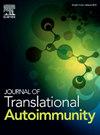PCI术后STEMI患者微血管阻塞的β1肾上腺素能受体自身抗体的预后价值:一项前瞻性队列研究
IF 3.6
Q2 IMMUNOLOGY
引用次数: 0
摘要
背景经皮冠状动脉介入治疗(PCI)后,ST 段抬高型心肌梗死(STEMI)患者经常会出现冠状动脉微血管阻塞(MVO),导致预后不良。β1肾上腺素能受体自身抗体(β1-AA)存在于各种心血管疾病中,并与心脏损伤和功能障碍相关。目的研究 STEMI 患者接受 PCI 后,β1-AA 与 MVO 发生之间的预后关系。方法这项前瞻性研究纳入了 403 名接受初级 PCI 的 STEMI 患者。将患者分为 MVO+ 组和 MVO- 组。在初级 PCI 之前测量血清 β1-AA 水平。主要结果是通过 PCI 后 5-7 天的心脏磁共振成像评估 MVO。与 MVO- 患者相比,MVO + 患者表现出更高的β1-AA 光密度(OD)。β1-AA OD、pNT-proBNP、pCK-MB 和 pTNI 与 PCI 后的 MVO 呈正相关。值得注意的是,β1-AA 水平与 MVO 风险之间的关联随着 pNT-proBNP 水平的增加而加强。β1-AA、pNT-proBNP 和 pTNI 的组合能最有效地预测 MVO,其 ROC 曲线下面积为 0.87(95 % CI:0.83-0.90)。β1-AA与pNT-proBNP和pTNI的结合提高了预测的准确性,为评估MVO风险提供了一种更稳健、更有效的策略。本文章由计算机程序翻译,如有差异,请以英文原文为准。
Prognostic value of β1 adrenergic receptor autoantibodies for microvascular obstruction in patients with STEMI with Post-PCI: A prospective cohort study
Backgrounds
Coronary microvascular obstruction (MVO) frequently occurs in patients with ST-segment elevation myocardial infarction (STEMI) following percutaneous coronary intervention (PCI), leading to poor prognosis. β1 adrenergic receptor autoantibodies (β1-AA) are present in various cardiovascular diseases and correlate with cardiac damage and dysfunction. However, whether β1-AA is associated with the occurrence of MVO in patients with STEMI after PCI remains unclear.
Aims
To investigate the prognostic relationship between β1-AA and the occurrence of MVO in patients with STEMI with post-PCI.
Methods
This prospective study included 403 patients with STEMI who underwent primary PCI. The patients were divided into MVO+ and MVO- groups. Serum β1-AA levels were measured prior to primary PCI. The primary outcome was MVO, assessed through cardiac magnetic resonance imaging at 5–7 days after PCI.
Results
A total of 127 MVO+ and 276 MVO– patients were identified. Patients with MVO + exhibited higher β1-AA optical density (OD) compared to MVO- patients. β1-AA OD, pNT-proBNP, pCK-MB and pTNI were positively associated with MVO following PCI. Notably, the assocition between β1-AA levels and MVO risk strengthened with increasing pNT-proBNP levels. The combination of β1-AA, pNT-proBNP and pTNI yielded the most efficient MVO prediction with an area under the ROC curve of 0.87 (95 % CI: 0.83–0.90).
Conclusions
β1-AA is significantly associated with the occurrence of MVO in STEMI patients following primary PCI. The combination of β1-AA with pNT-proBNP and pTNI improves predictive accuracy, providing a more robust and effective strategy for assessing MVO risk.
求助全文
通过发布文献求助,成功后即可免费获取论文全文。
去求助
来源期刊

Journal of Translational Autoimmunity
Medicine-Immunology and Allergy
CiteScore
7.80
自引率
2.60%
发文量
33
审稿时长
55 days
 求助内容:
求助内容: 应助结果提醒方式:
应助结果提醒方式:


